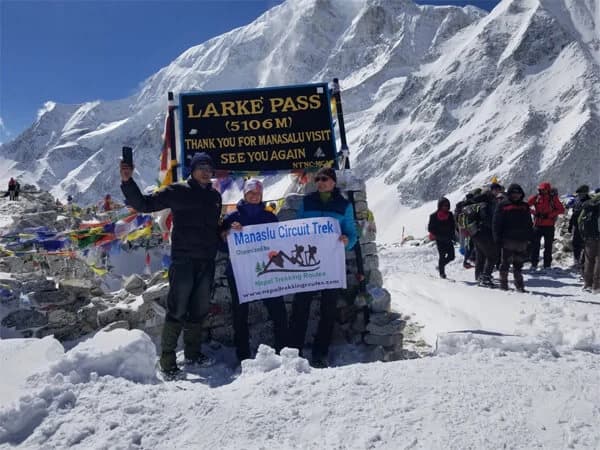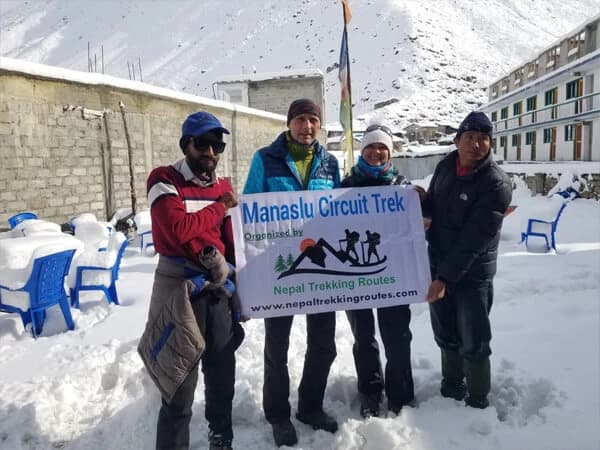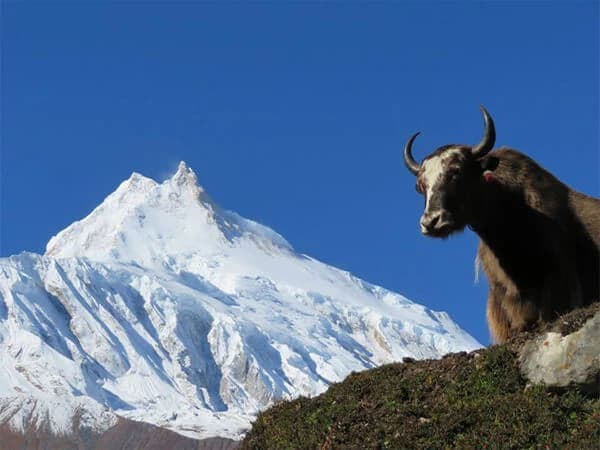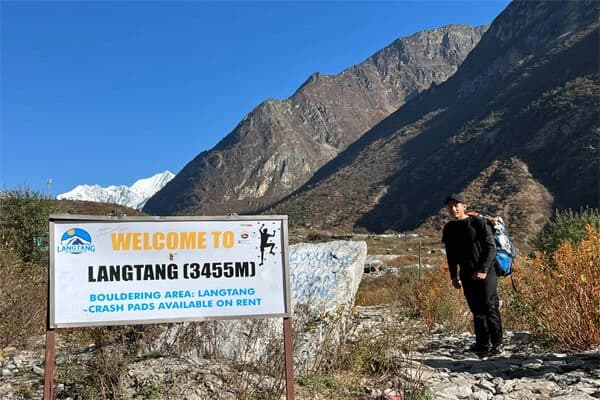Special Manaslu Circuit Trek permits are required to trek and access the area. The Manaslu Circuit is not just another trekking trail, it is a secret Himalayan treasure near the Tibetan border. The Nepali government has designated this area as restricted due to its uniqueness and sensitivity. This implies that you cannot simply arrive and begin to walk.
You may now ask, why are there so many rules? Why are permits required for mountain trekking?
The Manaslu region is home to remote villages and traditional communities. The majority of people here practice Tibetan Buddhism and live peacefully in the stunning surroundings. The government wishes to preserve their culture, land, and way of life. These villages are not comfortable with large-scale tourism. For this reason, they only permit visitors with guides and the proper permission. They restrict the number of trekkers in the region.
Permits also serve additional purposes. The funds are raised. They support local communities by constructing schools, establishing health facilities, and preserving the environment. Safety is another consideration. Permits allow trekking organizations and the government to keep tabs on trail users. This approach aids in the prompt organization of rescue or support during an emergency, such as landslides, illness, or heavy snowfall.
Therefore, obtaining a permit does require some additional preparation. However, it is a unique feature of the Manaslu journey. You transform from a trekker into a responsible traveler who respects the environment, the locals, and the laws that safeguard them.
Overview of the Manaslu Circuit Trek Permits
The Manaslu Circuit Trek is one of Nepal's most stunning but less-used trekking routes. It goes around Mount Manaslu, the eighth-highest mountain in the world at 8,163 meters. The trail offers deep valleys, rivers, stunning snow peaks, and tiny villages with strong traditions and a leisurely pace of life.
The trek often begins in Soti Khola or Machha Khola, and concludes at Dharapani, where it joins the well-known Annapurna Circuit trail. You pass through locations like Jagat, Philim, Lho, and Samagaun, each of which has something special to offer. You will sleep in comfortable teahouses with views of snow-capped peaks, across swing bridges high over rivers, and stroll through rhododendron forests.
The Larkya La Pass, a high mountain pass of more than 5,100 meters, is one of the main features. It is difficult due to the chilly wind and thin air, but the view is breathtaking once you reach the summit.
You need the appropriate permits because the trek passes through a restricted area (from Jagat to Dharapani). Since you cannot trek alone, you must have a certified guide and be in a group of at least two. This is a good idea as well as a rule. A guide can help you stay safe, find your way around, and discover the local way of life on this lengthy and isolated trek.
Depending on your schedule and pace, the Manaslu Circuit Trek itinerary is about 14 to 18 days. Unlike popular treks like Everest Base Camp or Annapurna Base Camp, it is ideal for trekkers seeking an exciting, cultural, and serene experience.
What Permits are requirements for Manaslu Circuit Trek
Three separate permits are required if you wish to trek to Manaslu Circuit. These permits are like special tickets, which let you enter and move through restricted or protected regions. Let's take a basic look at each.
Manaslu Restricted Areas Permit (RAP)
There are restrictions on the Manaslu region. This implies that it is not accessible to everyone. In order to safeguard its people, culture, and environment, the Nepali government requires trekkers to obtain a Restricted Area Permit, or RAP. This permit is required in order to do the Manaslu trek from Jagat to Dharapani.
You cannot obtain this permit alone. You must trek with a licensed guide and be with a group of at least two persons, and it must be organized through a registered Nepali trekking agency. It is not permitted to trek alone in this area.
Annapurna Conservation Area Permit and Manaslu Conservation Area Permit
The ACAP (Annapurna Conservation Area Permit) and MCAP (Manaslu Conservation Area Permit) are needed to enter protected areas during the Manaslu Circuit Trek.
Manaslu Conservation Area Permit (MCAP)
Manaslu is home to many unique animals, flora, and traditional villages. The region is therefore safeguarded as a conservation zone. The Manaslu Conservation Area Permit contributes to environmental preservation and local project funding. To enter the Manaslu region, each trekker needs to purchase this permit.
The MCAP is available from our trekking agency. It is a one-time cost that is independent of the number of days of your journey.
Annapurna Conservation Area Permit (ACAP)
The trail enters the Annapurna region after passing over the steep Larkya La Pass. You must obtain an additional permit known as the Annapurna Conservation Area Permit (ACAP) in order to enter this protected region. Similar to MCAP, this permit contributes to the preservation of local communities and the environment.
You need to have the ACAP from the start, even if it is the last leg of the journey. It is typically applied for by agencies along with your other permits.
Manaslu and Tsum Valley trekking permits
You will require two Restricted Area Permits for the Manaslu (Jagat to Dharapani) and Tsum Valley (Chumling to Nile/Chule) treks. Both need to be organized through a recognized trekking service and call for a certified guide. It is not permitted to trek alone in certain areas.
Manaslu Trek Permit Costs

Let's now discuss the cost of these permissions. The season and the number of days you spend in the restricted area determine the total cost. Here's a quick summary:
Cost of a Restricted Area Permit (RAP)
The Manaslu Circuit Trek Permit cost, which is the most costly of the three, varies according to the time of year you trek:
Autumn (September to November):
- USD 100 per person for the first 7 days
- After that, USD 15 per day
Winter, spring, and summer (December to August):
- USD 75 per person for the first 7 days
- After that, $10 USD per day
The Nepalese government sets these rates, which must be paid in US dollars.
Costs of Manaslu Conservation Area Permit and Annapurna Conservation Area Permit
The fees for these two conservation area permits are set:
- MCAP: around $30 per person
- ACAP: around $30 per person
For SAARC citizens (those from Bangladesh, Bhutan, India, and other nations), there might be discounts, but the cost remains the same for the majority of trekkers.
Therefore, the total permit cost for Manaslu Circuit trek might range from USD 135 to USD 200 or more, depending on how long you stay in the restricted area. Our trekking agency will help you with everything, so always check with them to get the most recent costs.
Where to Get Manaslu Circuit Trekking Permit
Obtaining the permits for the Manaslu Round Trek may seem complicated for foreigners. But it is actually very easy for a local trekking agency in Nepal. For this reason, you must get the permits through a registered agency like Nepal Trekking Routes.
Manaslu Conservation Area office in Kathmandu
The Manaslu permit office in Kathmandu is located at the Nepal Tourism Board (NTB) in Bhrikutimandap and the Department of Immigration in Maitighar. These offices work with registered trekking agencies to issue Manaslu permits. Trekkers cannot apply directly and must go through a licensed Nepal trekking company.
What are the Manaslu Circuit Trek Permit Rules
The Nepali government considers the Manaslu region to be a restricted area. This implies that not just anybody may enter and begin trekking. The objective is to preserve this isolated area's safety, culture, and natural beauty. Therefore, to go there, the government has this rule:
- Trekking alone is not permitted; your group must consist of at least two trekkers.
- You must have a certified guide with you.
- Permits must be obtained from a registered Trekking Company
Therefore, you will need to make some changes to your plans if you were planning to go on this trek alone or organize it yourself. But in all honesty, you benefit from this regulation. Having a guide and companion increases your safety and support on the lengthy and isolated trek.
How to get the Manaslu Circuit Trek Permits?
Here is a step-by-step process of application for permit:
Select an Accredited Trekking Company
First, look for a trekking firm that has a Nepal Tourism Board registration. Particularly in Kathmandu, there are plenty of possibilities. Everything from accommodations and permits to guides and porters can be arranged with the help of a reputable service.
Give the necessary documents.
Following your trek reservation, the agency will request some paperwork. These often consist of:
- A copy of a passport
- A copy of your visa for Nepal
- Two pictures the size of a passport
- The dates of your arrival and the beginning of your trek
Leave the paperwork to the agency.
Our trekking agency will handle the rest when you provide us with the necessary paperwork. On your behalf, we will go to the Nepal Tourism Board and the immigration office. It usually takes 1 to 2 working days to get all the permits ready.
Verify the permits before beginning.
Be sure to verify the permits one last time before you hit the path. Seek out:
- Your name spelled correctly
- The correct passport number
- Dates that are valid
- Region names (Annapurna and Manaslu)
Inform your Travel agency immediately if something seems off so they can address it.
Where Do the Permits Get Checked?

There are multiple checkpoints along the Nepal Manaslu trekking trail, located in settlements including Jagat, Philim, and Samagaun. You will be required to provide your permits at every checkpoint. You may be punished or even asked to return if you don't have them or if something goes wrong.
Therefore, it's crucial to have the appropriate permissions before beginning your trek. To put it briefly, obtaining your permits is not difficult, but it is also not something you do alone. Simply work with our trekking company in Nepal, provide us with the necessary paperwork, and we will take care of the rest. It's one of the procedures that guarantees your trip to Manaslu will be not only lawful but also seamless, secure, and unforgettable.
Permit Checkpoints on the Trail
During your trip along the Manaslu Circuit, you will encounter multiple checkpoints. At these checkpoints, local officials or government employees will request to see your trekking permits. Having all the necessary permits on hand at these times is crucial. You risk being penalized or, worse, being prohibited from continuing your journey if you don't.
The Significance of Permit Checkpoints
The "restricted region" is a unique place that the Manaslu Circuit trek passes through. To preserve the local population, culture, and environment, the Nepalese government needs to restrict the number of visitors to this region. Checkpoints for permits ensure that trekkers are following the regulations.
These checks contribute to your protection. Authorities may determine who is on the trail by looking up your permits. It's simpler to monitor trekkers in the event of an emergency or bad weather.
The locations of the checkpoints
In the following villages, you will typically be requested to present your permits:
- Jagat: Officials will frequently request your Restricted Area Permit (RAP) at this first significant checkpoint. Since Jagat is the designated entrance to the trail's restricted area, the guards there are extremely strict.
- Philim: Another village with a checkpoint after Jagat is Philim. They check your RAP again. Although your guide may take care of this for you, it is still a good idea to be informed.
- Namrung: Another location where officials review your documents is Namrung. You will now be trekking more into the Manaslu region.
- Samagaun: One of the largest and most picturesque villages along the route is Samagaun. To adjust and get used to the altitude, you may want to stay here for an additional day. Additionally, your permits are reexamined at this checkpoint.
- Dharapani: You will exit the Manaslu region and reach the Annapurna Conservation Area after crossing Larkya La Pass. Officers will verify whether you possess the ACAP permit here.
Every checkpoint serves to ensure that trekkers are law-abiding, safe, and considerate of the area.
What to Expect at a Checkpoint
The procedure is rather easy:
- Your permits are typically presented by your guide at every checkpoint.
- Your name, nationality, and passport number will be entered by an officer into their records.
- To prove your identity, you can be requested to present your passport.
- If your documents are in order, it normally only takes a few minutes.
The majority of the paperwork will be handled for you if you are traveling with a registered guide, which is necessary for the Manaslu Circuit. However, just in case, it's a good idea to have printed copies of your passport and permits with you.
What happens If You Lack the Correct Permits
This is crucial. If you don't have the appropriate licenses, you won't be able to pass a checkpoint. This cannot be avoided. You risk being severely punished, turned away, or even prohibited from trekking in Nepal going forward if you attempt to do so without authorization.
Trekkers have reportedly been stopped and forced to postpone their entire journey. This is why it's crucial to obtain your permits from our trekking organization and to confirm everything before you set off.
Last Word of Advice
Throughout the trek, keep your paperwork close to hand and secure. It may not seem like much, but it can save you a great deal of worry.
Manaslu Trek with guide
You may be excited about the prospect of trekking when you initially began organizing the Manaslu Circuit Trek. Walking through remote Himalayan villages, crossing High Mountain passes, and observing Nepal's breathtaking scenery can be a great experience. But then you find out something crucial: you can't go through this journey by yourself. The Nepalese government requires every trekker on the Manaslu Circuit to be in a company of at least two persons and have a registered guide. You may not be sure why this rule was in place. However, it makes more sense as you gain more knowledge.
Safety:

Unlike other well-known trekking routes in Nepal, the Manaslu Circuit is unique. Because of its greater remoteness, there are fewer tea cafes, emergency services, and trekkers. There might not be help available if something goes wrong, such as bad weather, an accident, or becoming lost. You will not be alone in these circumstances if you have a qualified guide with you. Most guides are equipped with a first-aid kit and are aware of what to do in case of altitude sickness or other medical issues. Many have even received training in mountain rescue.
Manaslu trek special permit:
The Restricted Area Permit (RAP) is one of the unique permissions required for this trek. Booking your journey through a government-registered trekking agency is the only way to obtain this permit. Additionally, a certified guide provided by the agency will accompany you. The rule requires that you have a guide for this trek, even if you consider yourself an expert trekker. It is a must, not only a recommendation.
Benefit beyond safety and regulations:
The majority of the guides are from neighboring mountain regions or local villages. They are knowledgeable about the terrain, the weather, and how to organize each day of the trek to prevent you from becoming too exhausted or missing anything crucial. They can also assist you in interacting with locals. Only Nepali or local tongues like Tibetan or Gurung are spoken in many of the communities along the trek. You can acquire a few native languages, participate in events if you're lucky, and gain an understanding of the culture with the aid of a guide.
And let's face it, having someone who can find you a good teahouse, check your room, and place your meal order in the local language is a tremendous help when you're exhausted, cold, and hungry after a long day.
Good guides are more than just assistants. They become a problem-solver, a storyteller, a travel companion, and occasionally even a buddy.
Therefore, it is true that you require a guide for the Manaslu Circuit. Consider it a smart move that will make your trip safer, more in-depth, and much more pleasurable, rather than a rule.
Tips to Make the Permit Process Smooth
Permits for the Manaslu Circuit Trek are easy to obtain, but proper application is important. The following useful advice can help to ensure a simple and seamless process:
Get Started Early
Don't put off applying for permits until the last minute. The process should ideally begin at least one week prior to the beginning of your trek. This prevents any delays and provides the time to gather the necessary paperwork.
Pick an Approved Trekking Company
Only trekking agencies registered with the Nepali government are authorized to provide permits for the Manaslu region. The Restricted Area Permit (RAP) is not something you can apply for on your own. A licensed agency will take care of all the paperwork for you and is aware of the regulations.
Provide the correct documents
Permit applications require the following documents. You must provide them to the trekking agency:
- A duplicate of your passport
- A current visa for Nepal
- Two pictures the size of a passport
Verify that your name and passport number are entered accurately on the paperwork. During the trek, minor errors can lead to issues at permit checks.
Check the number of Days
The number of days you spend in the restricted area determines how much the RAP costs. Thus, carefully schedule your trekking days. You could have to pay more if you remain longer than anticipated.
Take a Group Trip
To obtain the RAP, a minimum of two trekkers are required. Trekking alone is prohibited. Request the agency to let you join with another group if you are by yourself.
By following these steps, you can obtain your permits stress-free and have a peaceful trek.
Conclusion: Manaslu Circuit Trek Permit
Obtaining the appropriate permissions for the Manaslu Circuit is essential. It is a sign of respect for the locals, their way of life, and the natural beauty of the region. The funds obtained from these permits go toward maintaining the trekking paths, assisting local people, and preserving the environment. By following the regulations, you contribute to the preservation of nature and safety for upcoming trekkers. Responsible trekking includes preparation, consulting a local guide, and being aware of the significance of these permits. It's a tiny action that has a significant impact on everyone.












